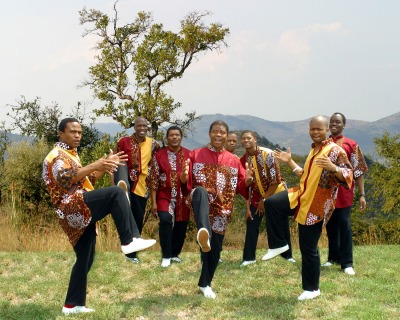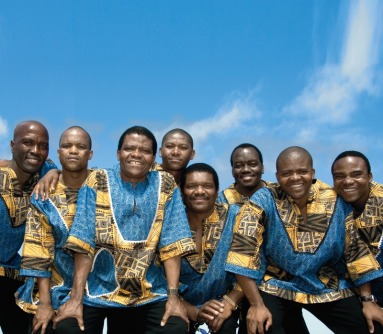Vocal style on a global journey
Published in Berkshire Eagle, 2/5/10

By Jeremy D. Goodwin
GREAT BARRINGTON—The group has performed for Queen Elizabeth, Pope John Paul II, and once teamed up with Sir Paul McCartney, Eric Clapton and others to perform a version of The Beatles’ “Hey Jude.”
From the townships of apartheid-era South Africa to two Nobel Peace Prize award ceremonies, Ladysmith Black Mambazo has performed around the world and elsewhere. For over 40 years, this a cappella group of South African men has brought its traditional Zulu isicathamiya vocal style to the world stage, and it had a front row view of history as apartheid fell in its home country.
Ladysmith Black Mambazo performs an afternoon show at the Mahaiwe Performing Arts Center on Sunday.
The high-profile show that hit closest to home for the group came from an unexpected call in 1990. Nelson Mandela had been released earlier that year, and the word was he had requested Ladysmith Black Mambazo to perform at his birthday celebration.
“When they called us onstage and we sang the song, before we finished the song Mandela stood up and walked straight to the stage. I remember his bodyguards were trying to stop him, but he just ignored them. He walked right on the stage and he joined us and he danced with us. It was the first time for us to see that he's got his own dance,” recalls longtime group member Albert Mazibuko during a telephone interview from his hotel in Ann Arbor, Michigan, the day before the start of the globetrotting group’s latest American tour.
“When we finished the song, before we could start another one he shook hands with all of us and he talked to us,” Mazibuko continues. “He said, ‘Keep up the good job guys, because your music has been a great inspiration for me when I was in jail.’ We were so taken aback. It was wonderful to say that.”
The relationship with Mandela continued. Mambazo performed when he received his Nobel Peace Prize in Oslo in 1993, and again at Mandela’s inauguration as president of South Africa the following year.
Though some chorus members have passed away and other have joined over the course of Ladysmith Black Mambazo’s remarkable journey, the core has been the extended family of leader and founder Joseph Shabalala.
GREAT BARRINGTON—The group has performed for Queen Elizabeth, Pope John Paul II, and once teamed up with Sir Paul McCartney, Eric Clapton and others to perform a version of The Beatles’ “Hey Jude.”
From the townships of apartheid-era South Africa to two Nobel Peace Prize award ceremonies, Ladysmith Black Mambazo has performed around the world and elsewhere. For over 40 years, this a cappella group of South African men has brought its traditional Zulu isicathamiya vocal style to the world stage, and it had a front row view of history as apartheid fell in its home country.
Ladysmith Black Mambazo performs an afternoon show at the Mahaiwe Performing Arts Center on Sunday.
The high-profile show that hit closest to home for the group came from an unexpected call in 1990. Nelson Mandela had been released earlier that year, and the word was he had requested Ladysmith Black Mambazo to perform at his birthday celebration.
“When they called us onstage and we sang the song, before we finished the song Mandela stood up and walked straight to the stage. I remember his bodyguards were trying to stop him, but he just ignored them. He walked right on the stage and he joined us and he danced with us. It was the first time for us to see that he's got his own dance,” recalls longtime group member Albert Mazibuko during a telephone interview from his hotel in Ann Arbor, Michigan, the day before the start of the globetrotting group’s latest American tour.
“When we finished the song, before we could start another one he shook hands with all of us and he talked to us,” Mazibuko continues. “He said, ‘Keep up the good job guys, because your music has been a great inspiration for me when I was in jail.’ We were so taken aback. It was wonderful to say that.”
The relationship with Mandela continued. Mambazo performed when he received his Nobel Peace Prize in Oslo in 1993, and again at Mandela’s inauguration as president of South Africa the following year.
Though some chorus members have passed away and other have joined over the course of Ladysmith Black Mambazo’s remarkable journey, the core has been the extended family of leader and founder Joseph Shabalala.

Inspired by dreams (literally) of a world class chorus singing original music in the isicathamiya style, Shabalala disbanded his then-current group and, in 1969, recruited members for what would become Mambazo.
Among the recruits Mazibuko, a first cousin.
For years the chorus was the brightest star on the still-active circuit of amateur isicathamiya competitions in the black townships of South Africa. Group lore has it that Mambazo was eventually barred from competing, due to its dominance. Though its first album, released in 1973, sold over 500,000 copies, the distinctly ethnic nature of its music and the realities of apartheid-era South Africa meant Mambazo spent over a decade leading a hard-traveling life of low-profile gigs and near constant travel hang-ups.
“Every time we are stopped by the police and asked, ‘Where are you going? Do you have permission to be here? What are you doing?” Mazibuko recalls.
Among the recruits Mazibuko, a first cousin.
For years the chorus was the brightest star on the still-active circuit of amateur isicathamiya competitions in the black townships of South Africa. Group lore has it that Mambazo was eventually barred from competing, due to its dominance. Though its first album, released in 1973, sold over 500,000 copies, the distinctly ethnic nature of its music and the realities of apartheid-era South Africa meant Mambazo spent over a decade leading a hard-traveling life of low-profile gigs and near constant travel hang-ups.
“Every time we are stopped by the police and asked, ‘Where are you going? Do you have permission to be here? What are you doing?” Mazibuko recalls.

Though the group’s combination of intricate vocal harmonies and distinctive dance steps syncopated with the music has remained constant, everything changed for Mambazo when Paul Simon called in the group to collaborate on what would become his breakthrough “Graceland” album in 1986. The next year Ladysmith Black Mambazo toured with Simon, appearing with him on Saturday Night Live as well as the concert film “The African Concert.”
“Everything was changed after that. After we did the world tour with him in 1987, when we went back home people were inviting us everywhere. Also, people at home saw that apartheid was starting to lose its power. They scrapped the [travel restrictions] so that we were now allowed to go anywhere and sing anywhere and do a show wherever we want. So, from there our audience was a [racially] mixed audience.”
As veritable ambassadors a once-marginalized cultural heritage, Mambazo has more in mind than simply delivering a good show.
“It is more than entertaining. Most of our aim is to encourage people to leave a positive life,” Mazibuko says. “We wish our music, if you listen to it, it will bring something to you that is going to make you see the world or your life in a different way.”
As such, after forty years of touring and performing, Ladysmith Black Mambazo has a distinctive warm-up procedure suited to its history and motivations.
“The most preparation when we go on tour is to tune our minds,” Mazibuko explains. “We pray, we fast, we go to the mountain. We just dedicate a day that we'd be there, talking to God and encouraging one and another and talking about all the things we want to happen to us. Then, after that we pray. And then we practice the songs.”
“Everything was changed after that. After we did the world tour with him in 1987, when we went back home people were inviting us everywhere. Also, people at home saw that apartheid was starting to lose its power. They scrapped the [travel restrictions] so that we were now allowed to go anywhere and sing anywhere and do a show wherever we want. So, from there our audience was a [racially] mixed audience.”
As veritable ambassadors a once-marginalized cultural heritage, Mambazo has more in mind than simply delivering a good show.
“It is more than entertaining. Most of our aim is to encourage people to leave a positive life,” Mazibuko says. “We wish our music, if you listen to it, it will bring something to you that is going to make you see the world or your life in a different way.”
As such, after forty years of touring and performing, Ladysmith Black Mambazo has a distinctive warm-up procedure suited to its history and motivations.
“The most preparation when we go on tour is to tune our minds,” Mazibuko explains. “We pray, we fast, we go to the mountain. We just dedicate a day that we'd be there, talking to God and encouraging one and another and talking about all the things we want to happen to us. Then, after that we pray. And then we practice the songs.”
